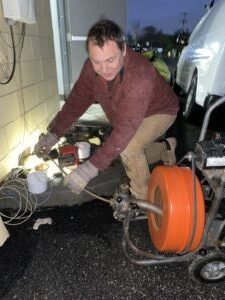Today we’re addressing one of the most common questions that General Pipe Cleaners gets asked, how to load a cable into a drum machine.
It might seem like a simple task, but loading your cable correctly makes a huge difference in how well your machine performs—and how much hassle you’ll avoid down the line. If the cable is loaded in backwards, you’re more likely to deal with issues like kinks, cable looping inside the drum and difficulty reloading the cable after a job is finished.
Here are three key pointers to help you load your cable properly and extend the life of both your cable and your machine:
- Drum Connecting Cable Counterclockwise in Drum
The drum connecting cable is always attached, and from where it’s attached, it runs counterclockwise around and out through the distributor tube.
When the cable is properly loaded, it ensures smooth operation, reduces the risk of damage to the Flexicore® cable, and helps prevent job site delays. General Pipe Cleaners’ drain cleaning machines are designed to work seamlessly with this counterclockwise cable orientation, making proper loading critical for performance.
- Cable Turns to The Left at Bottom of Drum
If you take the distributor tube and point it down towards the ground at a six o’clock position, you’ll notice the cable bending to the left as it exits that tube.
This left-hand bend is a quick visual check to ensure the cable is correctly aligned for use. Professional plumbers rely on this method to avoid cable tangling or binding inside the drum, which can lead to unnecessary wear on the cable and machine parts.
- Pulling Cable Rotates Inner-Drum Clockwise
As the cable comes out, it’s clockwise, and when put back in, it’s counterclockwise. We’re talking about the distributor tube and the drum assembly.
Remember, this clockwise-out, counterclockwise-in motion is consistent across General Pipe Cleaners drum machines, helping professionals avoid equipment issues on the job. Loading a cable backwards may seem minor, but it can lead to major problems like reduced torque, cable kinking, and even breakdowns that interrupt critical drain cleaning work.
Need a step-by-step video?
Watch this quick tutorial from the Drain Brains® at General Pipe Cleaners.
Loading your cable correctly plays a big role in the overall performance and longevity of your drum machine. By remembering these three key points, you’ll reduce wear and tear, avoid kinks and ensure a more efficient job every time. Taking a few extra minutes to load your cable the right way can save you a lot of time and trouble down the road.
For best results, always use General Pipe Cleaners’ Flexicore cable, designed specifically for professional-grade durability and performance in demanding drain cleaning applications.
Why Loading Your Cable Correctly Matters
Proper cable loading is essential for maximizing the performance and longevity of your General Pipe Cleaners drum machine. Incorrect loading—especially reversing the cable direction—can lead to operational problems like kinking, binding inside the drum, and premature wear on the Flexicore cable. These issues not only slow you down but can also shorten the lifespan of your equipment.
Taking a few extra minutes to ensure the cable is loaded correctly helps you avoid these headaches and keeps your machine running at peak performance—job after job.
Common Questions from the Field
Q: What happens if I load a cable backwards in a drum machine?
A: Loading the cable backwards can cause the cable to kink, bind inside the drum, and make reloading more difficult after a job. It can also add unnecessary stress on the machine and the cable itself, leading to premature wear.
Q: What type of cable should I use with my drum machine?
A: For best results, General Pipe Cleaners recommends using our Flexicore® cable, designed specifically for professional-grade durability and performance in demanding drain cleaning applications.
Q: How can I tell if my cable is wearing out or needs replacing?
A: Signs of cable wear include visible kinks, frayed wires, or reduced flexibility. If the cable feels stiff or has flat spots, it’s best to replace it to avoid equipment damage or on-the-job failures.
Q: How often should I inspect my cable and drum machine for maintenance?
A: It is good practice to inspect your cable and drum machine before and after each use. Regular inspections help catch early signs of wear and tear so you can replace components before they cause breakdowns in the field.
Q: Can I use a Flexicore cable with any drum machine brand?
A: Flexicore cables are designed for General Pipe Cleaners’ machines, ensuring maximum performance and compatibility. Using them with other brands may not deliver the same results and can cause issues with fit and operation.
Q: Are there different types of cables for different drain cleaning jobs?
A: Yes—General Pipe Cleaners offers a variety of cable sizes and types to match specific applications. For example, smaller diameter cables are ideal for sinks and small lines, while larger, more robust cables are used for demanding jobs like clearing tree roots in mainlines. Always refer to the machine’s manual for recommended cable pairings.
Need help? Contact the Drain Brains® at General Pipe Cleaners at 800-245-6200 or email [email protected].
